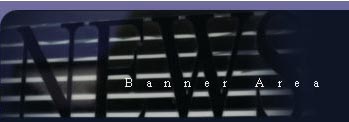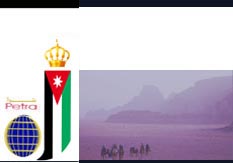 |
|
|
|
|
  |
| Jordan News Agency |
 |
|||||||||||||||
| Member's Area | |||||||||||||||
|
|
|||||||||||||||
|
|
|||||||||||||||
| |||||||||||||||
|
|
About Jordan |
|
|
About Us |
|
|
News |
|
|
Services |
|
|
Photo Gallery |
|
|
Useful Links |
|
|
Voting Poll |
|
|
Contact Us |
|
|
Home |
|
1. Overview 2. News Services
3. Stages of Petra's
Technical Development
Overview Jordan News Agency (PETRA) has witnessed important developments on technical and professional levels since it was first established in 1969, as an independent body linked to the Ministry of Information. The Royal Decree by virtue of which PETRA was established stated that the mission of PETRA is to "achieve the goals of the Jordanian media by covering news and transmitting them both inside and outside Jordan through proper technical means". Petra's news bulletins reflect the diversity of opinions in Jordanian society and further the cause of democracy in the Kingdom. PETRA started with 32 employees, 18 of them were journalists who provided an evening news bulletin typed in both Arabic and English, and disseminated to all those concerned: media, press, Arab and foreign embassies and some ministries and government departments. PETRA increased its daily working hours to 18, including Fridays and official holidays. However, it can work around the clock in times of emergency. The staffs also increased to reach 238 employees, 135 of them are journalists who enjoy membership of the Jordan Press Association (JPA). PETRA is a fully-fledged professional body that participated actively in the inception of the JPA.
PETRA became an independent entity in June 2004, following the
dissolvement of the Ministry of Information. A special ordinance was
enacted to give PETRA financial and administrative independence and to
specify the powers of the Agency's Council and those of the
Director General. · Items in the photos, news and documents archives, · Special press services requested by local and foreign organizations, · Services of the T.V unit and leasing its equipments, · Professional, press and technical training. · Special news bulletin. · Advertisement on its Internet site. News services: PETRA provides news services in Arabic and English on its main outlet. The average Arabic daily news dispatches is 70-90, whereas this stands at 20-30 news items for the English bulletin. These figures might change according to daily events and activities inside and outside Jordan. Petra's bulletin is aired on its website. The number of visitors to the website stands at 3-4 million monthly. It reached 7 million in March 2004. PETRA provides photos of the daily events and activities covered on its website. It provides direct dispatches to 22 subscribers, including Arab and foreign news agencies' offices in Amman and agencies with which it has signed agreements such as the Qatari, Yemeni and Syrian news agencies. In 1997, PETRA started a TV filming and editing unit funded by the Japanese International Cooperation Agency (JICA) that is part of a studio. In early 2005, the unit was upgraded. In 2005 too, a training center was founded in PETRA, equipped with the necessary computers and a data show. Many training courses have been held for Petra's journalists and media persons from governmental institutions since its foundation. The center, funded by UNESCO, longs to be a regional training center for journalists. PETRA renders its news services through · Direct telephone line to the agency provided by Jordan telecom, accompanied by a program to browse news. · Through an FTP service where every subscriber is provided with technical information, user name and password. The subscriber is required to have an Internet connection, a computer and a news browser. · Through Arabia 2000 satellite package that is transmitted by United Press International (UPI). · Through Petra's two websites: petra.gov.jo and petranews.gov.jo, in addition to the website of the Federation of Arab News Agencies (FANA): www.fananews.com
Stages of Petra's Technical Development It has come a long way since news bulletins were distributed internally through systems that feed communication lines and the mechanical tele-printers, that later changed to computer sets, PETRA has now fully computerized news services.
§ PETRA started to distribute its bulletins to subscribers internally, through systems that feed communication lines and the mechanical tele-printer, that later changed to computer sets. · In 1976, PETRA started to transmit news on VHF short waves to the Arab world and Europe for 6 hours/day. · In 1992, PETRA computerized its press activities: reception and dispatching of news and archiving. · In 1994, PETRA developed its archive system by using an ORACLE database and high capacity storage equipment. · By virtue of an agreement signed with the UPI in 1995, PETRA started to transmit news through satellite that reaches all parts of the world. · In 1997, PETRA developed with UNESCO support an electronic photo archiving system that helped the agency to store more than 100,000 photos out of 500,000 photos it owns that depict some very important events in the history of Jordan and the region. · In 1998, PETRA got connected to the Internet; it launched its first website of news and photos. Frequent upgrades have been conducted on the website to cope with the latest information and technological developments. · In 1999, PETRA introduced a new version of its news system (nepras) to confront the Y2K threat. The new version integrated the data, photo and documents archiving systems. · In 2001, PETRA introduced a program enabling its journalists in local governorates and abroad to access the nepras system through the Internet. By virtue of this system, journalists can access nepras from whatever place they work from typing their own reports and pasting them to the editing page. · In 2004, PETRA developed programs that allow automatic upgrading of news and photos on its website. It also introduced an electronic monitoring system that records news bulletins, store them electronically and use them in Petra's bulletins. · PETRA is currently using an internal system linked to two servers working with Windows 2000 system.
|
